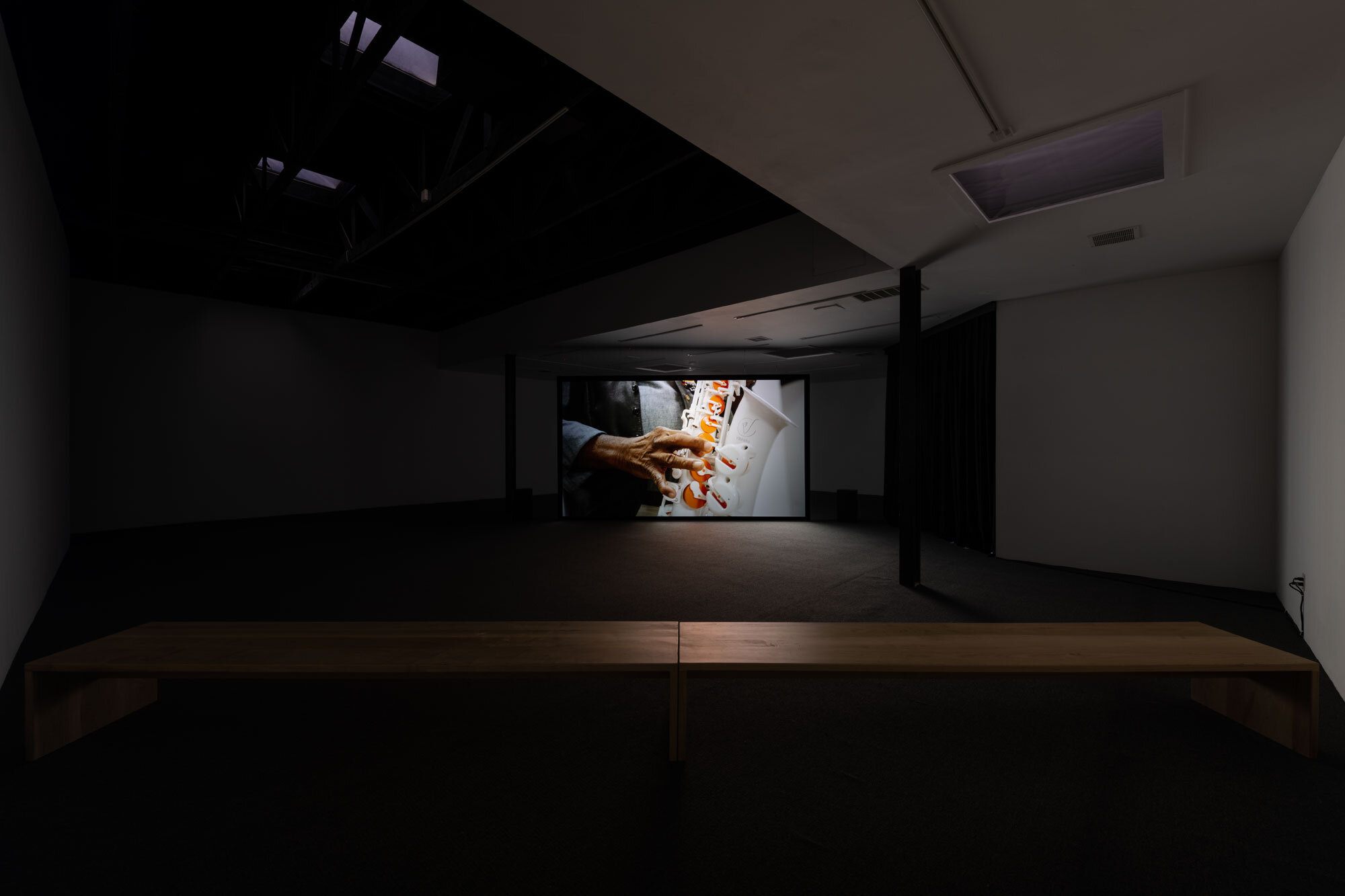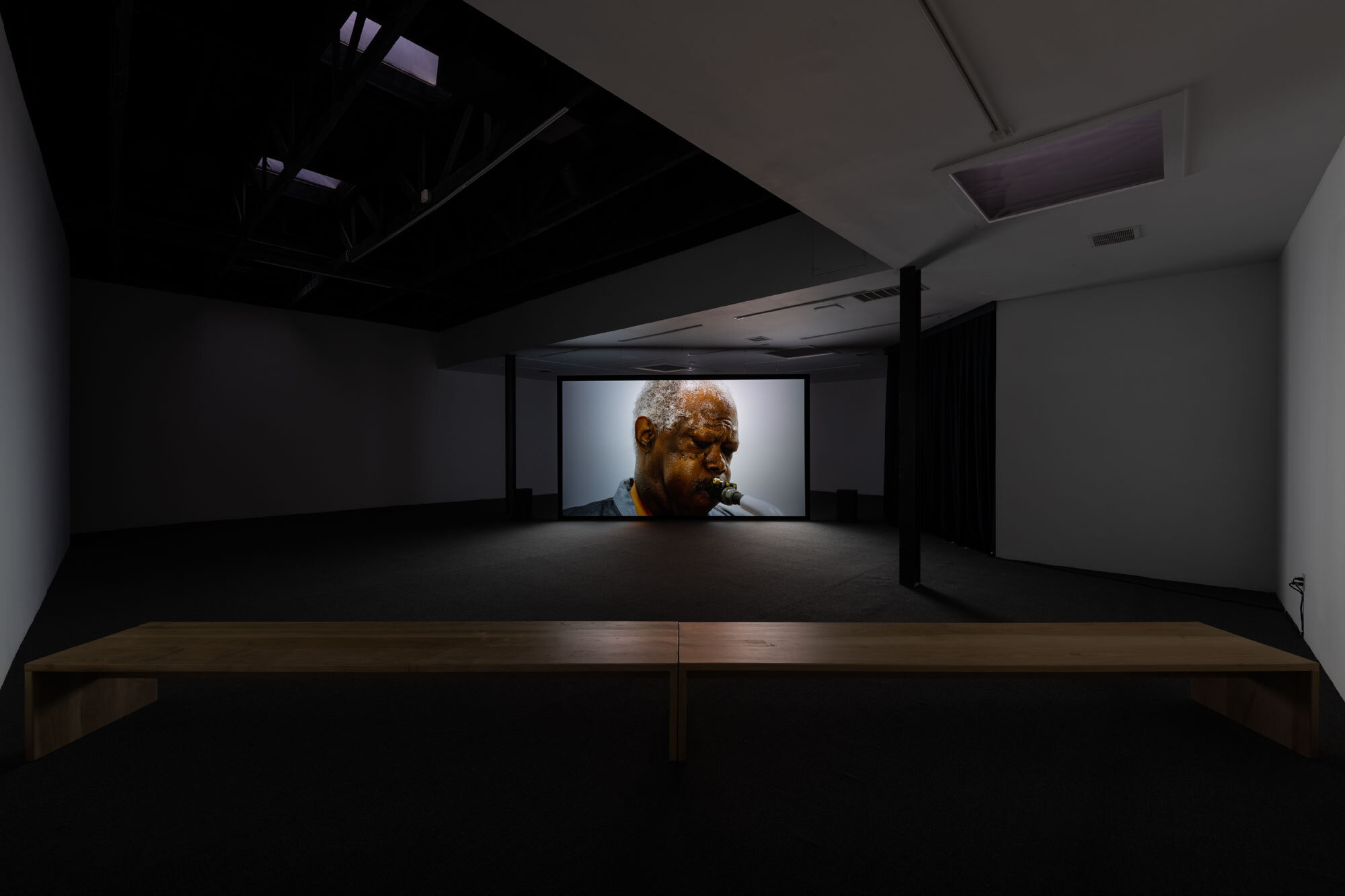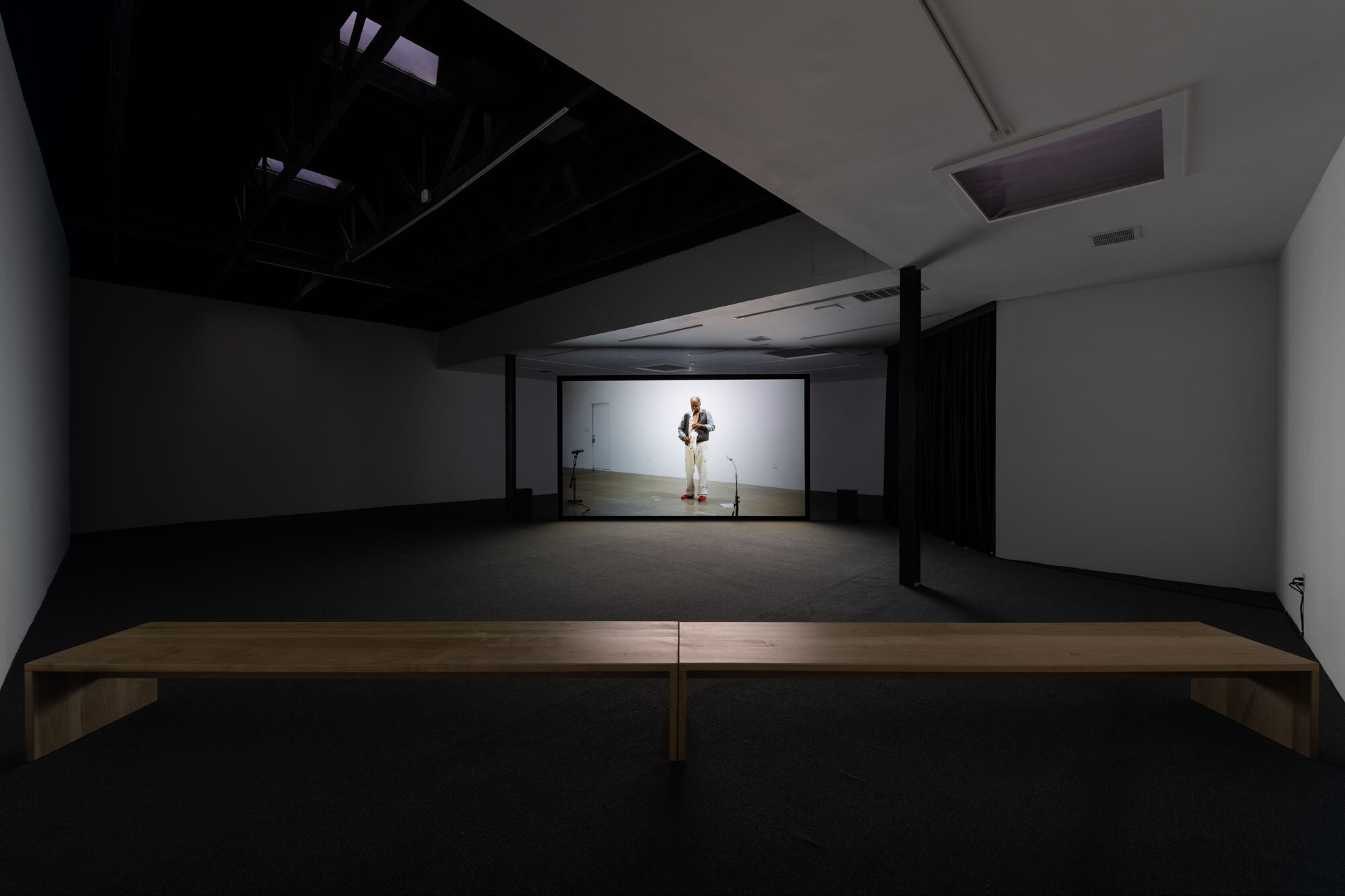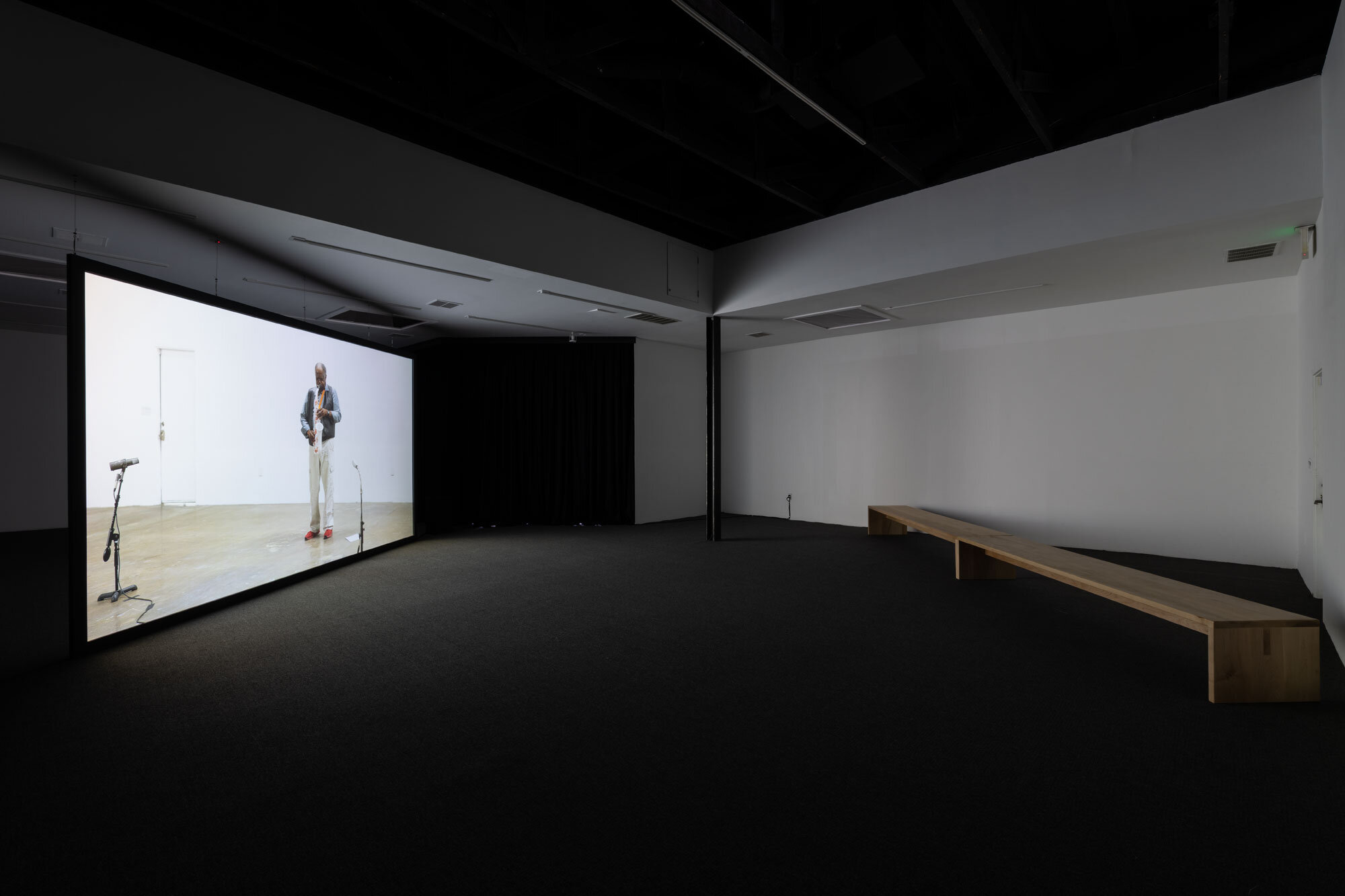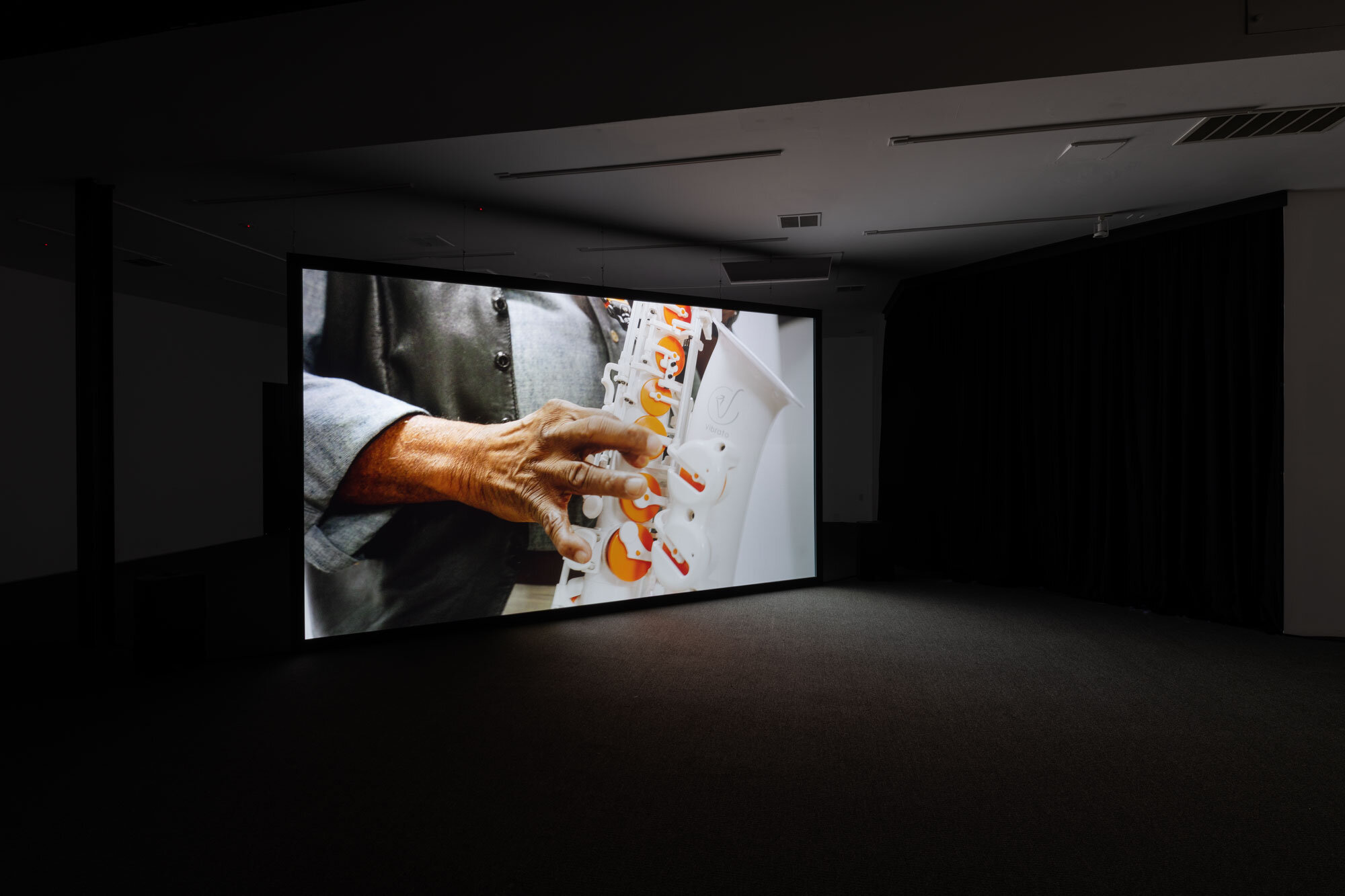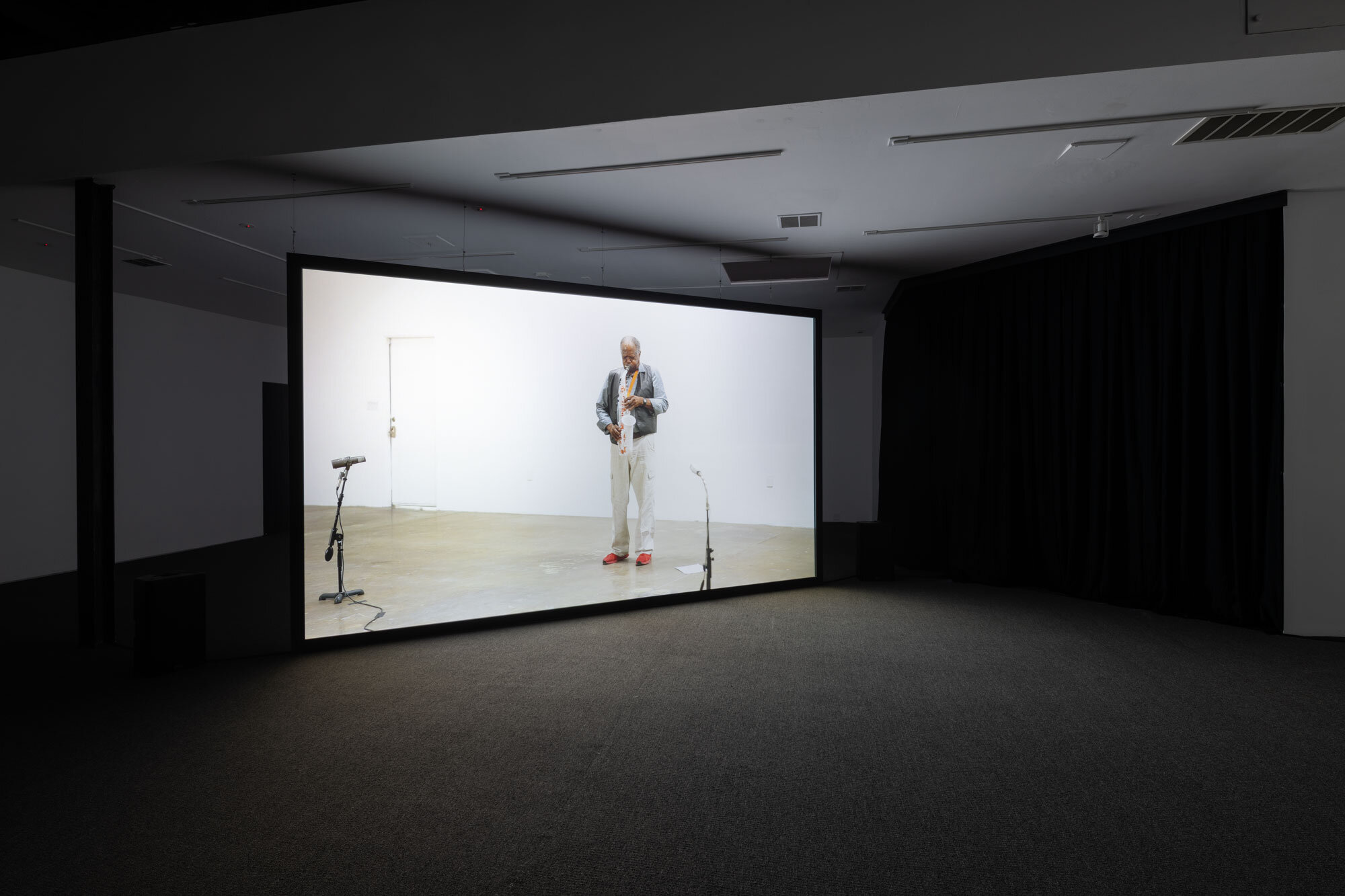Alone Together
09.25 // 11.06
Ari Marcopoulos
Joe mcphee
For the better part of its life, LAXART’s building was a recording studio. Home to Golden Sounds, Studio 56, and the legendary Radio Recorders, a veritable Who’s Who of musical talent has passed through its doors. Alone Together, a newly commissioned video featuring trumpeter/saxophonist Joe McPhee as filmed by photographer Ari Marcopoulos, reinstates the gallery’s role as a recording facility.
Alone Together is a lean 25 minute video documenting a poetry reading and alto saxophone performance by McPhee whose solo work, within the history of avant-garde jazz and improvised music, is canonical. McPhee is a consummate improviser. And while the performance is improvised, there are key phrasings and gestural flourishes serving as refrains structuring the piece, which runs a gamut of emotions, its beauty and lyricism sprouting from aggression and vice versa. Set in an empty gallery, the video is marked by a transparency of means as its three cameras not only capture McPhee but the barebones production apparatus--microphones, camera operators and a brief glimpse of the gallery staff which doubled as a meager live studio audience.
There are many facets to Marcopoulos’ practice. A New York denizen since 1980, Marcopoulos (b. 1957) is perhaps best known for chronicling hip hop’s early days. Although it was never his intention, Marcopoulos went on to become a much sought after editorial photographer, covering the worlds of music, fashion, art and their intersection. Rather than looking for the work, the work often found him. He is drawn to sites of creativity and expression with New York’s streets being an extremely fertile cultural petri dish. While the streets may compel Marcopoulos at times to be a street photographer, at its core, his is a diary practice, a tell-tale sign being the date stamp gracing much of his work. His subject is ultimately whatever captures his attention, wherever he may find himself. In short, his subject is life, it just so happens to be a life hopelessly enmeshed within the fabric of culture, high and low, popular and underground.
Portraiture is a mainstay of Marcopoulos’ work and Alone Together is a prime example. Marcopoulos used a three camera set up while doing all the hand-held, close-up work himself. He is a big fan of the music and it shows. He anticipated the performance’s peaks and valleys, gauging when to exploit such intimate access to his subject. In a game of come and go, Marcopoulos witnessed the performance’s most intense moments at point blank range, soaking up the textures of both performer and performance, from McPhee’s moans, growls and beads of sweat to the nimble fingering of the horn’s keys.
McPhee is a stalwart tenor man. Upon learning Charlie Parker recorded here, he thought the performance called for an alto. As for the make of saxophone, the white and orange polycarbonate Vibrato was no doubt a choice inspired by Ornette Coleman, who played a plastic saxophone to much notoriety. All this to say, McPhee stands on very broad musical shoulders. And he’d be the first to humbly acknowledge this.
A long time Poughkeepsie native, McPhee (b. 1939) began his career as a trumpeter in a milieu where the figures brokering the advent of Free Jazz in the late 50s and early 60s were still highly active. McPhee took up the tenor saxophone in the late 1960s after hearing Albert Ayler, a seminal figure whose playing expanded the tenor saxophone’s range so as to encompass screeches, squeals, shrieks, honks and multiphonics above and beyond its traditional register. A bulwark of Free Jazz, this expanded technique was a fitting expression of the depth and magnitude of anger, grief, longing, and sorrow that accompanied aspirations for systemic change. They are, likewise, a standard part of McPhee’s vocabulary and are being redrafted into service as the present demands.
Alone Together is named for a poem written by McPhee and recited in the video’s opening minutes. While the title’s immediate reference is to a collective isolation engendered by the pandemic, the poem itself is an invective whose sentiments are fueled by COVID’s death toll. It is a scathing indictment of the Trump administration to the degree that the virus and the presidency are referenced interchangeably throughout the poem.
The poem begins “On a day the world stood still/it arrived in the dead of winter/ushered in on a cold wind from hell.” It is not until a few lines later, when McPhee references “Morning In America,” the slogan for Ronald Reagan’s 1984 presidential campaign, that it becomes clear that winter as a season not only marked the arrival of the virus but also Trump’s inauguration. With or without COIVID, Reagan’s Morning in America, under the auspices of Trump, has become mourning in America.
The poem’s directness renders it a précis announcing a performance taking up the task of mourning. Courtesy of its integral connection to breathing, the saxophone already lends itself to a rhetoric of the soul. Abiding by these notions, McPhee grounds the performance in breath. But here, the essence of life is at the service of singing of and for the dead. McPhee’s brusque and strained vocalizing cannot help but come across as a form of channeling, his horn an instrument for all the souls who, unable to be in the presence of loved ones at the time of death, “began their journey to forever/alone together.“
Joe McPhee—who was born in Miami, Florida in1939, and lives and works in New York—is an American jazz multi-instrumentalist, a player of tenor, alto, and soprano saxophone, the trumpet, flugelhorn and valve trombone. He began playing trumpet when he was eight, before learning other instruments. He played in various high school and then military bands before starting his recording career. His first recording came in 1969, when he appeared on the Clifford Thornton album Freedom and Unity. McPhee taught himself saxophone at the age of 32 after experiencing the music of John Coltrane, Albert Ayler, and Ornette Coleman. During the late 1960s and early 1970s, McPhee lectured on jazz music at Vassar College. In 1981, McPhee met composer, accordionist, performer, and educator Pauline Oliveros, whose theories of “deep listening” strengthened his interests in extended instrumental and electronic techniques. He was also inspired by Edward de Bono’s book Lateral Thinking: A Textbook of Creativity in developing his own “sideways thinking” approach to improvisation.
McPhee has not yet signed with any major label in his native United States, and was possibly better known throughout Europe than his native country until the 1990s. With a career spanning over 50 years and over 100 recordings, he continues to tour internationally, forging new connections while reaching for music’s outer limits.
Ari Marcopoulos—who was born in Amsterdam in 1957 and moved to New York City in 1980—is an artist, filmmaker, and photographer currently living and working in New York. He has been the subject of several solo exhibitions, at Fotografiemuseum Amsterdam, the Netherlands; Berkeley Art Museum in California; MoMA PS1, New York; galerie frank elbaz, Paris; Marlborough Chelsea, New York; and Alleged Gallery, New York, among other locations.
Marcopoulos participated in two Whitney Biennials (in 2002 and 2010), and his photographs are in collections including the Whitney Museum of American Art, New York; San Francisco Museum of Modern Art; New Orleans Museum of Art; and Detroit Institute of Arts. His work has been published in the New York Times Magazine, Interview, Paper, Blind Spot, Transworld Snowboarding, and Snowboarder. His films include the documentary Larry Wright and Key to the Riddle, a documentary on the artist Forrest Bess. Among Marcopoulos’s many books are Epiphany: Gucci (Idea, 2016), Not Yet (Rizzoli, 2016), Rome–Malibu (Roma, 2016), Fumes (Karma, 2015), Out to Lunch (Roth, 2012), Directory (Nieves/Rizzoli, 2011), Out and About (Damiani, 2005), Kids Born out of Fire (Perks and Mini, 2004), Pass the Mic: Beastie Boys 1991–1996 (powerHouse, 2001), and Transitions and Exits (powerHouse, 2000).
Generous support provided by the Andy Warhol Foundation for the Visual Arts.

